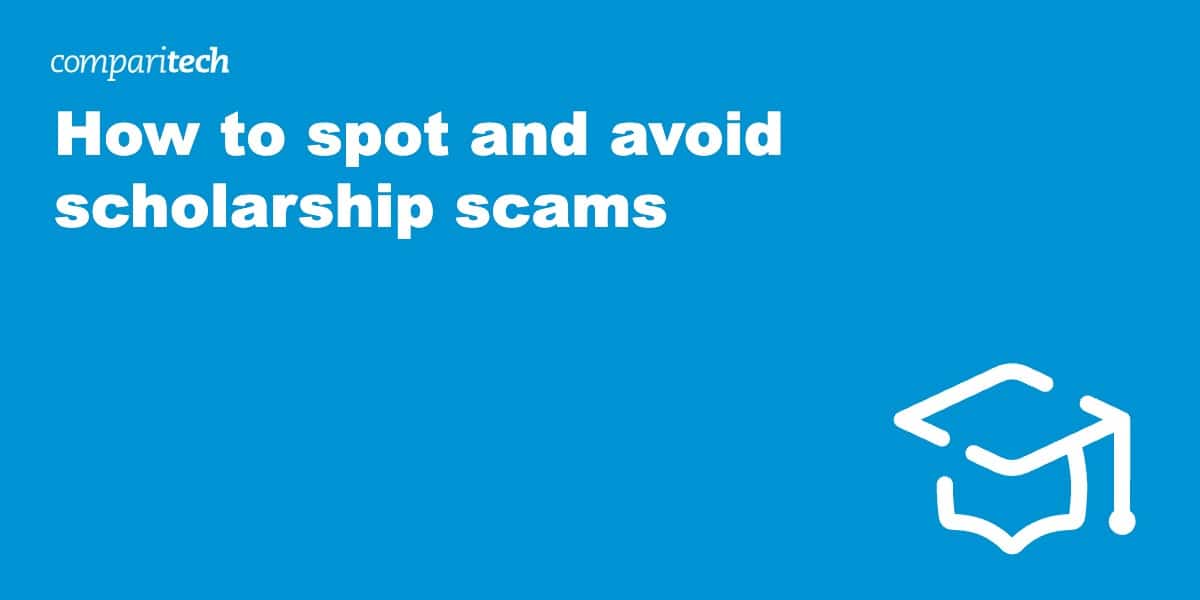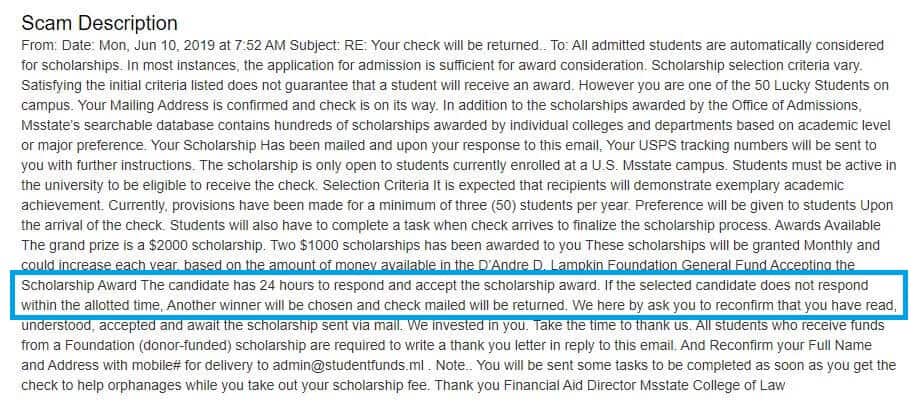There’s no denying that education is expensive. US students typically leave college with an average loan debt of $28,950. Taken together, these students owe an eye-watering $1.75 trillion. But not all students are saddled with debt. Some manage to snag scholarships that help with everything from tuition fees to accommodation.
Unfortunately, scammers understand that the lure of financial aid can be used to trick desperate students. If you’re planning on going to – or are already attending – college, read on to find out how to spot and avoid scholarship scams.
Types of scholarship scams
First, let’s take a look at the most common scholarship scams circulating online today. Scholarship scams come in many different forms, but often follow the pattern of traditional ruses, such as phishing schemes and overpayment scams. The promise of a scholarship is simply what the fraudster running the scam has chosen as their guise, and they are specifically targeting students.
Phishing schemes
A phishing scheme often starts with an email sent to a large number of recipients, but communication may begin via a phone call (vishing) or SMS message (smishing).
According to Been Verified, an online public records company with a reverse phone number identification tool, messages involving student loan scams were among the 12 most common attempts at fraud over the last three years.
The idea is that the scammer is “phishing” for information, such as your name, address, phone number, Social Security number, or banking information.
Here are a few phishing email scenarios:
- The email requests information such as your address and phone number and promises to send more information about a scholarship.
- There’s an application form attached to the email that the sender wants you to complete and send back.
- The email includes a link to an application form on a legitimate-looking website which is actually a “phishing site” designed to steal your information.
In each case, chances are, instead of getting information about or applying for a scholarship, you’re really just sending detailed information that a scammer could use in various types of fraud, even identity theft.
These emails could be sent out indiscriminately by the thousands in the hopes that they will trick at least some unsuspecting students. However, in other cases, attacks could be targeted (this is known as spear phishing).
As an example, a criminal could obtain a student email list for a particular university. They could then craft a very convincing phishing scheme aimed at swindling those students.
One such scheme in 2016 targeted students at Queen Mary University London. Students received an email purportedly from the schools’ financial aid department (complete with the school logo) offering a government educational grant. They were asked to hand over personal and banking information in order to receive the grant. Thieves then used these details to withdraw funds from at least one student’s bank account.
Advance-fee scams
Similar to a phishing scheme, an advanced-fee scam is often initiated via email. In this case, the scammer will ask for some type of fee to be paid. This could, for example, be in return for more information or for your application to be submitted. This should be a huge red flag. Information about scholarships should be available publicly and for free.
In other advance-fee scams, you’re told you’ve been selected for a scholarship that you haven’t even applied for. There’s often the catch that you need to pay some type of transfer or administration fee before you can get the money. In reality, no money will ever be sent your way.
Some fee-based scholarship scammers go to great lengths to make their scheme appear legitimate, often by genuinely awarding a large scholarship. While this might not sound like a scam, imagine that 20,000 people pay an application fee of $10. If the organizers pay out a $40,000 scholarship, they still get to walk away with $160,000 in their pockets. What’s more, their reputation remains intact so they can carry out the ruse over and over, even targeting the same individuals.
Sales pitch schemes
In your quest to find a scholarship, you may be invited to a seminar on the topic. Be very wary of these as they can turn into high-pressure sales pitches.
Some scholarship seminars really do stick to the topic of financial aid, but you still need to have your wits about you. There’s a high risk that the organizers will take some type of fee and either walk away with the money, or pay out a nominal amount to make the whole thing look legitimate.
Some organizations purport to be helping people with scholarships, but instead are using the guise to try to sell other products or services. This tactic might be used by firms selling insurance or investment products, usually things you don’t need or want and very likely can’t afford anyway. If you’re invited to a scholarship seminar or one-on-one interview regarding financial aid, there’s a chance that this is where it’s heading.
Overpayment scams
Overpayment scams are very tricky to weed out and can be used for a whole host of products and services, including scholarships. The thing about these scams is they really play on your trust as there is an upfront payment (to you) involved.
Here’s the gist:
- You receive a letter in the mail stating you have been selected for a scholarship. A check comes in the mail with the letter or shortly afterward. Delighted, you deposit the check in your bank account.
- Very soon after the check arrives, you receive a letter or email, stating that there has been an overpayment of part of the sum.
- Still content with having received at least some money, you send back the portion that was “overpaid.”
- The check never clears and you are now out of pocket for the “overpayment.”
Criminals will even set up a legitimate-looking application process before putting the overpayment scheme into action.
Lottery-based scholarships
Lottery-based scholarships are not necessarily scams, but they may be something you want to avoid. The way these typically work is you complete surveys in return for entry into a prize draw (the prize being a scholarship). There are many legitimate lottery-based scholarships out there that do pay out money to the winner.
But there is a catch. No real skill is required to win these lotteries, but rather a winner is drawn at random. The company providing the scholarship is making money off the information you provide when you complete a survey by selling it to third parties.
They then pay out a small portion of this profit as a scholarship. This is similar to some fee-based schemes as discussed above. But instead of paying money to enter, you’re giving up your personal information.
In this model, the organization needs a large number of applicants to make the scheme profitable. As a result, your chances of winning are very slim. The odds may be no better (or worse) than when you buy a scratch card from your local convenience store.
One example of this type of scheme is ScholarshipPoints.com where you take surveys to earn points that can be used to enter scholarship lotteries.
How to spot and avoid scams
Scammers can be very crafty and scholarship scams may be difficult to spot, especially when you’re ever so hopeful that someone really does want to help you pay for your education. Here are some tips for spotting and avoiding these types of schemes.
Here’s how to avoid Scholarship scams:
- Question if it’s too good to be true
- Be wary of a sense of urgency
- The promise of exclusive information should be a red flag
- Question money-back guarantees
- Ignore claims of unclaimed funds
- Watch out for claims of affiliation with a reputable organization
- Learn to spot phishing emails and websites
- Don’t hand over personal or banking information
Let’s delve into those in more detail:
1. Question if it’s too good to be true
Use common sense and question how likely it is that the information being presented is legitimate. Let’s face it: if something sounds too good to be true, it probably is.
2. Be wary of a sense of urgency
While some scholarships do have deadlines, you likely wouldn’t be contacted a few hours or days beforehand. In fact, it’s unlikely that someone providing a real scholarship would ever contact you asking you to apply. Crooks use the tactic of creating a sense of urgency to throw you off your guard and comply with whatever they’re asking.
For example, below is a June 2019 scam report from the Better Business Bureau (BBB) Scam Tracker. This scholarship scam phishing email included a timeframe within which the recipient should respond (24 hours). Otherwise, the sender threatened, someone else would be selected for the scholarship.
3. The promise of exclusive information should be a red flag
If an organization is promising exclusive access to a scholarship, question whether this would make sense. Information about the vast majority of scholarships is made publicly available so that everyone who is eligible will have an equal opportunity to apply.
4. Question money-back guarantees
Some fraudsters will use a money-back guarantee offer to persuade you to pay them a fee. But let’s face it, the only way they’d be able to guarantee you a scholarship is if the process is rigged. As the Federal Trade Commission (FTC) highlights:
Legitimate companies never guarantee or promise scholarships or grants.
Another claim that may be used to attract your attention is the promise that everyone is eligible. Of course, for a real scholarship, there is a set of criteria that applicants have to meet to be considered for the prize.
5. Ignore claims of unclaimed funds
There has long been a myth circulating that millions of dollars in scholarship funds go unclaimed every year. In reality, this is a ploy to help persuade more students to hand over their information or money to apply for bogus scholarships.
6. Watch out for claims of affiliation with a reputable organization
Plenty of scammers will claim to have ties with an organization that you recognize. Some will go a step further and pose as that organization, for example by using its logo and possibly even an email address and web domain that looks like it’s from the company. Investigate the organization thoroughly before handing over any information.
7. Learn to spot phishing emails and websites
Some phishing schemes are easy to spot while others are sophisticated and very deceiving. Key things to look out for are poor spelling and grammar, an email domain that doesn’t quite match the organization’s name, and links that appear to go to different domains (hovering over a link will show you where it’s going to send you).
In the UK, scammers targeting students typically pose as the Student Loan Company (SLC). They use threatening language and try to coerce students into clicking on links, which will take them to sites asking for their personal information and bank details.
If you do end up clicking through to a website, tell-tale signs of a phishing site include lack of contact and “about us” information and outdated copyright information.
8. Don’t hand over personal or banking information
When you apply for a scholarship, you’re going to have to hand over some information. But if an organization is asking for things like your social security number or banking information right off the bat, then it is likely a scam. Even for seemingly innocuous information like your name, address, and phone number, you should fully vet the organization before sending.
How to report scholarship scams
Do you suspect someone is trying to scam you? Or have you or someone you know already fallen victim to a scholarship scam? The government is aware that such scams are taking place and has taken steps to prevent it, including devising the College Scholarship Fraud Prevention Act of 2000 (P.L. 106-420), which created enhanced penalties for scholarship fraud.
However, law enforcement agencies still struggle to prosecute in such cases, often due to lack of information and evidence. Many people simply don’t report scams, often because they feel ashamed or believe they have no hope of getting their money back. Just bear in mind that reporting scams can help to alleviate the problem by providing authorities with additional information and raising overall awareness.
We have an article dedicated to reporting scams but here’s a handy list of contacts for the US and a few other countries:
US
- National Fraud Information Center (NFIC) (Phone 1-800-654-7060)
- The attorney general’s office for your state
- Better Business Bureau (Phone 1-703-525-8277)
- Postal Crime Hotline (Phone 1-800-654-8896)
UK
Canada
Australia
- ACCC Scamwatch
- Department of Human Services Scams and Identity Theft Helpdesk (Phone 1800 941 126)
- ReportCyber (for cybercrime)
Where to find information about legitimate scholarships
We’ve covered a lot of information about how to avoid scholarship scams, but what about finding a legitimate scholarship provider? Thankfully there are plenty of organizations out there that genuinely want to help. Here are some places to look:
- High school guidance counselor
- College financial aid advisor
- Fast Web Scholarship Search
- College Board’s Big Future Scholarship Search
- Niche Scholarship Search
Just bear in mind that certain scam sites may find their way into some scholarship search services, so it’s always good to think twice and do some thorough checks before submitting your information.



